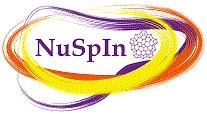Sprecher
Dr.
Magdalena Matejska-Minda
(HIL Unversity of Warsaw)
Beschreibung
The medium-light 45Sc nucleus, situated in the nuclear chart above doubly magic 40Ca, has additional 1 proton and 4 neutrons beyond the Z = N = 20 shell closure. The number of active particles and the p3/2f7/2 configuration space are big enough to allow for the collective motions of nucleons. The negative-parity states built on the 7/2− ground state exhibit a spherical structure, while a well deformed rotational-like band is formed upon the Iπ =3/2+ intruder level at 12.4 keV [1-2]. Our attention is addressed to the positive parity band built on the low-lying, T1/2 = 318 ms isomeric state at the energy of 12.4 keV and spin 3/2+ .
To study the electromagnetic properties of low-lying excited states in 45Sc, Coulomb excitation experiment was performed in November 2016 at the Heavy Ion Laboratory. The γ-rays depopulating Coulomb excited states in the nuclei of interest were detected by the EAGLE spectrometer composed of 16 Compton- suppressed HPGe detectors. Collected data are analyzed using the coupled-channel, least-squares search code GOSIA [3] with the aim of determining matrix elements between low-lying excited states. The measured γ-ray intensities will enable us also to evaluate the B(E3) transition probabilities, in particular: the excitation probability from the ground state to the first excited isomeric state: B(E3, 7/2− → 3/2+) so far only upper limit is known [4], while the B(E3, 7/2- → 5/2+) is unknown. In this contribution, the recently performed measurement
will be described and the initial results will be presented.
[1] M. Avgoulea et al., J. Phys. G: Nucl. Part. Phys. 38, (2011) 025104.
[2] P. Bednarczyk et al., Eur. Phys.J. A 2, (1998) 157.
[3] T. Czosnyka, D. Cline, and C. Y. Wu, Bull Amer. Phys. Soc. 28, (1983) 745,
http://slcj.uw.edu.pl/en/gosia-code/.
[4] A.E. Blaugrund, R.E. Holland and F.J. Lynch, Phys. Rev. Vol. 159, no. 4, (1967) 926
∗ This work is supported by the Polish National Science Centre under the FUGA3 postdoctoral fellowship grant No. DEC - 2014/12/S/ST2/00483 and under the Harmonia Programme grant No. DEC - 2013/10/M/ST2/00427. This project has received funding from the European Union’s Horizon 2020 ENSAR2 research and innovation programme under grant agreement No 654002.
Autor
Dr.
Magdalena Matejska-Minda
(HIL Unversity of Warsaw)

